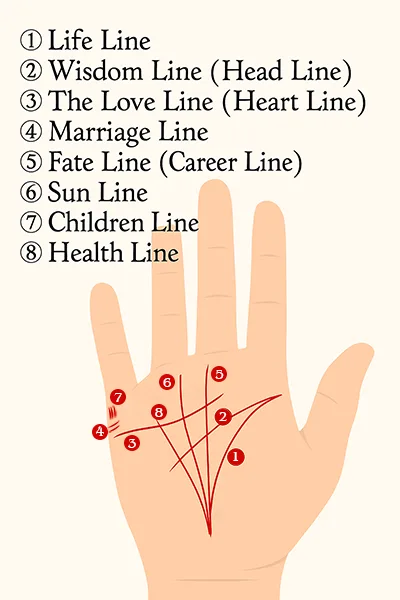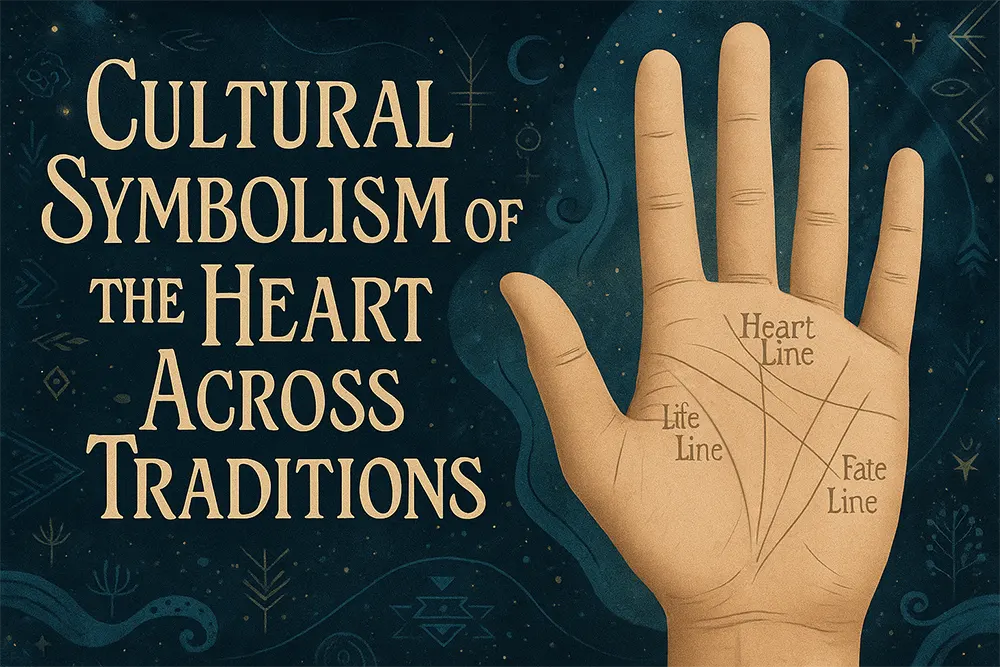In the ancient art of palmistry, also known as chiromancy, the lines etched into our palms are believed to hold profound insights into our personalities, destinies, and emotional worlds. Among these, the heart line stands out as a captivating feature, often referred to as the “love line” or “emotional line.” This prominent crease, curving across the upper palm, symbolizes not just romantic inclinations but also our capacity for empathy, compassion, and interpersonal connections. Across various cultures and traditions, the heart line’s symbolism has evolved, reflecting diverse philosophies on love, emotions, and human relationships. Whether viewed through the lens of Western mysticism, Indian Vedic astrology, or Chinese fortune-telling, the heart line offers a window into how societies interpret the human heart’s mysteries.
This exploration delves deep into the cultural symbolism of the heart line in palmistry, uncovering its meanings in different traditions. We’ll examine its historical roots, variations in interpretation, and how it mirrors broader cultural values. For enthusiasts of palm reading, understanding the heart line can enhance self-awareness and provide guidance in navigating emotional landscapes. As we journey through these traditions, we’ll see how this simple line on the hand encapsulates universal themes of love and vulnerability, tailored to each culture’s unique worldview.
Understanding the Heart Line: Basics of Palmistry
Before diving into cultural specifics, it’s essential to grasp the fundamentals of the heart line in palmistry. Typically, the heart line is the uppermost major line on the palm, starting from the edge beneath the pinky finger (the Mercury finger) and arching toward the index finger (Jupiter finger) or middle finger (Saturn finger). Its position, length, depth, and curvature provide clues about one’s emotional disposition.
In general palm reading practices, a long, deep, and unbroken heart line suggests a person who is open-hearted, affectionate, and capable of deep emotional bonds. Conversely, a short or faint line might indicate emotional reserve or challenges in expressing feelings. Branches or forks on the line can symbolize multiple romantic interests or complex emotional experiences, while chains or islands may point to periods of emotional turmoil or heartbreak.
The heart line doesn’t exist in isolation; it interacts with other major lines like the head line (representing intellect) and the life line (symbolizing vitality). For instance, if the heart line merges with the head line, it could indicate a person whose emotions are heavily influenced by logic, leading to balanced but sometimes cautious relationships. These basic interpretations form the foundation upon which cultural variations build, adapting the symbolism to fit societal norms and spiritual beliefs.
Palmistry itself dates back thousands of years, with evidence of hand reading in ancient civilizations. The heart line, in particular, has always been associated with matters of the heart—pun intended—reflecting humanity’s enduring fascination with love and connection.
Historical Origins of Palmistry and the Heart Line
The practice of palmistry has ancient roots, traceable to civilizations like India, China, Egypt, and Greece. In these early societies, the heart line was not merely a predictor of romance but a symbol of inner harmony and spiritual health.
In ancient India, palmistry—known as Hasta Samudrik Shastra—was integrated into Vedic astrology. Texts like the Puranas mention hand lines as indicators of karma and dharma. The heart line, or “hridaya rekha,” was seen as a reflection of one’s emotional karma, influencing relationships and family life. Similarly, in ancient China, palm reading was part of physiognomy, where the heart line symbolized yin energy, balancing the yang of intellect and action.
Western palmistry, influenced by Greek and Roman traditions, evolved during the Renaissance. Aristotle is said to have written on chiromancy, linking palm lines to character traits. The heart line gained prominence in medieval Europe, often interpreted through astrological lenses, with mounts (fleshy pads on the palm) named after planets like Venus for love.
Across these origins, the heart line’s symbolism consistently revolves around emotional expression, but cultural contexts add layers. In nomadic traditions like those of the Romani people, the heart line might predict marital bliss or romantic adventures, emphasizing freedom and passion.
The Heart Line in Western Palmistry: Emotions and Individualism
In Western palmistry, popularized in Europe and North America, the heart line is primarily associated with romantic love, emotional intelligence, and personal relationships. This tradition emphasizes individualism, viewing the line as a map of one’s unique emotional journey.
A curved heart line in Western interpretations often denotes a romantic, idealistic nature—someone who wears their heart on their sleeve and seeks passionate connections. If it ends under the index finger, it suggests a balanced approach to love, blending emotion with ambition. A straight heart line, however, indicates a more rational, controlled emotional life, where feelings are expressed thoughtfully rather than impulsively.
Branches upward from the heart line symbolize positive emotional growth, such as falling in love or forming deep friendships, while downward branches might warn of disappointments or losses. In modern Western palm reading, influenced by psychology, the heart line is also linked to emotional health, with breaks indicating stress or trauma that could benefit from therapy.
Culturally, this symbolism aligns with Western values of personal fulfillment and romantic idealism, as seen in literature and art. For example, in Victorian-era palmistry books, a strong heart line was prized as a sign of true love, reflecting the era’s emphasis on courtship and marriage.

Western practitioners often combine the heart line with elemental hand types—fire hands (passionate) amplify its romantic symbolism, while earth hands (practical) temper it with stability. This approach highlights how the heart line embodies the Western pursuit of self-actualization through relationships.
The Heart Line in Indian Palmistry: Karma, Devotion, and Family Bonds
Indian palmistry, deeply rooted in Hinduism and Vedic traditions, interprets the heart line through the prism of karma, dharma, and spiritual growth. Known as the “manibandh rekha” or heart line, it symbolizes not just romantic love but devotion (bhakti), family ties, and emotional purity.
In Vedic texts, a deep, clear heart line indicates a person with strong familial bonds and the ability to love unconditionally, aligning with concepts like “vasudhaiva kutumbakam” (the world is one family). If the line is long and curves upward, it suggests success in love marriages or harmonious partnerships, often blessed by divine favor. A wavy or chained line, however, might signify emotional obstacles due to past karma, requiring remedies like wearing gemstones or performing rituals.
Cultural symbolism here emphasizes collectivism over individualism. The heart line is linked to the heart chakra (anahata), representing compassion and forgiveness. In arranged marriage contexts, a balanced heart line predicts compatibility and longevity in unions.
Variations include the “simian line,” where heart and head lines merge, symbolizing intense focus but potential emotional overwhelm. Indian astrologers often cross-reference the heart line with horoscopes, adding astrological depth— for instance, a Venus-influenced line enhances sensuality.
Remedies for a weak heart line might involve chanting mantras or wearing coral rings, reflecting India’s holistic approach to emotional well-being. This tradition underscores the heart line as a symbol of devotional love, extending beyond romance to spiritual connections.
The Heart Line in Chinese Palmistry: Harmony, Balance, and Relational Dynamics
Chinese palmistry, or “mian xiang,” integrates Taoist principles of yin-yang balance, viewing the heart line as an indicator of emotional harmony and relational fortune. Positioned at the palm’s top, it’s called the “love line” or “emotion line,” revealing insights into romantic potential and family life.
A straight heart line parallel to the head line signifies emotional control and stability, embodying the Confucian ideal of harmonious relationships. If it connects to the life line, it implies deep-rooted family ties, where emotions are intertwined with longevity and health. Curved lines suggest passion but potential volatility, needing balance through practices like feng shui.
In Chinese culture, the heart line symbolizes filial piety and marital bliss. A forked end might predict multiple relationships or children, aligning with traditional values of progeny. Breaks could indicate health issues affecting emotions, like heart conditions, prompting consultations with traditional Chinese medicine.
This tradition often examines both hands—the left for innate traits, the right for developed ones—adding nuance to interpretations. The heart line’s symbolism reflects China’s emphasis on social harmony, where personal emotions serve the greater good of family and society.

The Heart Line in Other Global Traditions: Diversity in Symbolism
Beyond the major traditions, the heart line holds unique symbolism in other cultures. In Romani (Gypsy) palmistry, it’s a predictor of romantic adventures, with a vibrant line indicating passionate, nomadic love stories. Arabic palmistry, influenced by Islamic mysticism, views it as a sign of inner peace and devotion to Allah, where a clear line suggests emotional purity.
Ancient Egyptian palm reading, tied to hieroglyphics, associated the heart line with the god Thoth’s wisdom on love and afterlife bonds. In African traditions, like those in Yoruba culture, it might symbolize ancestral connections and communal love.
These diverse interpretations highlight the heart line’s universal appeal, adapting to local spiritual and social frameworks.
Comparative Analysis: Common Threads and Cultural Divergences
Comparing traditions reveals commonalities: the heart line universally represents emotions and relationships. However, divergences arise from cultural priorities—Western individualism vs. Eastern collectivism.
In the West, it’s about personal romance; in India, karmic devotion; in China, balanced harmony. These differences reflect societal values, yet all underscore the heart line’s role in fostering human connection.
Modern globalization blends these, with practitioners incorporating multicultural insights for richer readings.
Modern Interpretations: The Heart Line in Contemporary Society
Today, the heart line’s symbolism extends to psychology and self-help. Therapists use palmistry metaphorically to discuss emotional patterns, while apps digitize readings for accessibility.
In pop culture, it’s featured in movies and books, symbolizing destiny in love. Despite skepticism, its enduring appeal lies in offering hope and introspection.
Frequently Asked Questions (FAQs) About the Heart Line in Palmistry
What does a broken heart line mean across cultures?
In Western palmistry, it often signifies emotional setbacks like heartbreak. In Indian traditions, it may indicate karmic lessons requiring spiritual remedies. Chinese interpretations link it to imbalances in yin energy, suggesting health checks.
How does the heart line differ between hands?
The dominant hand shows current emotional state, while the non-dominant reveals innate traits. This holds in most traditions, emphasizing personal growth.
Can the heart line change over time?
Yes, lines can evolve with life experiences, symbolizing emotional development in all cultures.
What if I have no heart line?
Rare, but it might suggest emotional detachment. Consult a professional for personalized insights.
How accurate is heart line palmistry?
While not scientific, it’s a tool for self-reflection, valued culturally for guidance.
Conclusion: The Timeless Symbolism of the Heart Line
The heart line in palmistry transcends borders, embodying humanity’s quest for love and connection. From Western romance to Eastern harmony, its cultural symbolism enriches our understanding of emotions. Whether seeking guidance or curiosity, exploring the heart line invites deeper self-awareness. In a world of fleeting connections, this ancient line reminds us of the enduring power of the heart.

Related Posts
Case Study: Health Line and Lifestyle Choices
Fate Line Starting from Life Line vs Head Line: Unlocking the Secrets of Your Career and Destiny in Palmistry
Crosses, Stars, and Breaks on the Fate Line in Palmistry
Multiple Marriage Lines in Palmistry – Interpreting Emotional Bonds
Cross-Cultural Interpretations of the Head Line
Faint Mercury Line – Does It Indicate Weak Health?